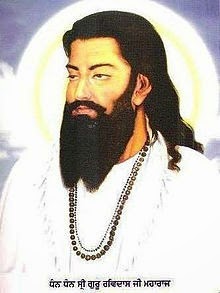Sikh music or Shabad kirtan is
Kirtan-style singing of hymns or
Shabad from the
Guru Granth Sahib, the central text of Sikhism and compositions of some mystic gurus of Sufi and Bhakti movement.
It began in the 16th century as the musical expression of mystical poetry conceived by
the founder of Sikhism, Guru Nanak. Following him, all the Sikh gurus sang in the then-prevalent classical and folk music styles, accompanied by stringed and percussion instruments.
The style was where the text was of prime significance and the music played a supporting, albeit important, role. The Gurus specified the raagin which they sang each hymn in the Sikh sacred scripture, the Guru Granth Sahib.
Sixty raags were and sixty raag variants were named. Several raag variants are unique to the Sikh music tradition.
While Hindustani music underwent significant changes in the setting of Mughal courts, and a separate stream of Carnatic music developed in southern India, Sikh music retained its original form and styles, a unique musical tradition encompassing a variety of melodic forms and a well-developed percussive system.
In the 20th century, the classical style was largely replaced by contemporary popular genres often based on Indian film music. Within the remaining classical tradition, the devotional Gurmat Sangeet style was overtaken by the darbaari khayal style. The harmonium took the place of stringed instruments and the tabla replaced the pakhaavaj and jori. Significant efforts have been under way since the 1970s to revive the rich Sikh music tradition initiated and developed by the Sikh Gurus. Various terms used to refer to this tradition include Shabad keertan parampara, Gurbani sangeet parampara and Gurmat sangeet.
Sikhs follow the teaching of Nanak, Kabir, as in Gurmat, Kabir, Ravidas, Bhatts all are same and all are treated as Guru and Sikhs bow before Guru Granth Sahib which include the teaching of many who had similar thoughts about God.
Bani in Guru Granth Sahib: 974 Shabads in 19 Ragas,Gurbani Includes: Japji, Sidh Gohst, Sohilaa,
Guru Nanak (1469 - 1539), the founder of Sikhism and the first of the ten Gurus of the Sikhs, was born in the village of Talwandi.
The four feet of Dharma, the four castes were converted into one. Equality of the King and beggar, he spread the custom of being humble. Reversed is the game of the beloved; the egotist high heads bowed to the feet.
Full Name : Ravidas, RaidasBirth : 30 January 1399, Benaras, Uttar Pradesh, IndiaDeath : Benaras, Uttar PardeshOther Info: 500 verses in Guru Granth Sahib.
Ravidas (also Raidas) was a North Indian Guru mystic of the bhakti movement from Ramanandi Sampradaya and one of the direct disciples of Ramananda. He was active in the 15th century CE. Venerated in the region of Punjab, Uttar Pradesh as well as Maharashtra, his devotional songs and verses made a lasting impact upon the bhakti movement.One of the most touching, written and sung, composition of Sant Ravidas as kirtan:
Madho Sat Sang Tumare Hum Auguan Tum Pukare
O Madho, along with taking refuge in holy company, I take refuge in you. I have many shortcomings and hence I call upon you.
Tum Chandan, Hum Irand bapare, Sang Sumare Vaasa
Neech Rupe Te Ucch Payain Hain, Gandh Sugandh Nivasa
You are the sandalwood tree, we are simple insects living in your fragrance.
Though born in lower birth, I am rising up! Like the lowly smell rising above.
. . . . . Sat Sangat Meel Raheye Sadhu, Jaise Madhup Makhira
I want to live as honey bees live around the honeycomb, in holy company always.
Jati Ocha, Pati Ocha Janam Hamara
Raja Ram Ki Sev Na Kini Kah Ravidas Chamara
Lower is my birth, lower is my caste, Nor Have I Done Service to the Lord Ram
That is the sweeper called Ravidas says
Bahut Janam Bichare Madho Eho Janam Tumare Lekhe
Keh Ravidas Aas Laga Ne O Chir Payeo Darshan Dekhe
O Madho, I have been separate from you for so many births; this birth is written for you—offered to you
Ravidas says now I have deep desire to see you; a long time has gone by without seeing you, O Lord, O Madhoji.
Full Name : Kabirdas
Birth : 1440, Uttar Pradesh, India
Death : 1518, Maghar, Uttar Pardesh
Other Info: 500 verses in Guru Granth Sahib.

Bhagat Kabir or Saint Kabirdas (1441-1518) was a Devotee, Saint and Gurmukh born in Uttar Pardesh, India. He was a monotheist and follower, probably founder, of Gurmat. There are 227 Padas in 17 ragas and 237 slokas of Kabir in Guru Granth Sahib. He is revered by Hindus,Muslims and Sikhs, some Sikhs even use the word Guru in reference to Kabir. Like other Devotees, Kabir did not believe in Ritualism, the worshiping of Dieties, the Caste System. Kabir played the role of a teacher and social reformer by the medium of his writings. Bhagat Kabir guided Gurmat to Ramanand, whom he adopted as worldly guru. The Kabirpanthi sect which follow the teachings of Kabir, referring to him as their guru.
























.jpg)
.jpg)
.jpg)

.jpg)
.jpg)
.jpg)
.jpg)
.jpg)



.jpg)
.jpg)

.jpg)
.jpg)


.jpg)
.jpg)
.jpg)

.jpg)

.jpg)
.jpg)
.jpg)
